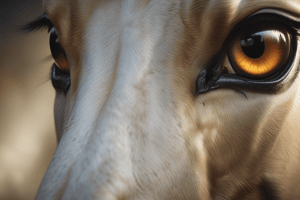Podcast
Questions and Answers
Horses are obligate nasal breathers, which poses risks during anesthesia, especially for nasal congestion and atelectasis.
Horses are obligate nasal breathers, which poses risks during anesthesia, especially for nasal congestion and atelectasis.
True (A)
Nasotracheal intubation is useful for
Nasotracheal intubation is useful for
- Emergency C section
- Teeth floating procedures
- Surgeries of the head and neck (correct)
- Epistaxis
Horses are more likely to develop
Horses are more likely to develop
- Hypoventilation (correct)
- Hypotension (correct)
- Hypoxemia (correct)
- Hypertension
A triple drip is a combination of guaifenesin, ketamine, and xylazine (or any
other alpha2-agonist)
A triple drip is a combination of guaifenesin, ketamine, and xylazine (or any other alpha2-agonist)
Nystagmus in horses is a sign of recovery and readiness for extubation
Nystagmus in horses is a sign of recovery and readiness for extubation
During the post anesthetic period you should never muzzle the horse
During the post anesthetic period you should never muzzle the horse
Flashcards
Horse Anesthesia Risk
Horse Anesthesia Risk
Horses' reliance on nasal breathing creates risks during anesthesia, particularly from nasal congestion and lung collapse.



